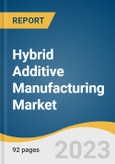The growing demand for customized products across various industries has led to the development of new manufacturing methods, including hybrid additive manufacturing. This technology combines traditional subtractive manufacturing with additive manufacturing methods to produce complex, high-quality, and customized products. In addition to customization, hybrid additive manufacturing offers other advantages such as reduced material wastage, improved production speed, and reduced costs.
The COVID-19 pandemic had a negative impact on the market for hybrid additive manufacturing. The pandemic disrupted global supply chains, leading to raw materials, components, and equipment shortages. This has affected the hybrid additive manufacturing sector, as many manufacturers rely on imported materials and equipment. Despite the challenges, the pandemic had also accelerated the adoption of additive manufacturing in the medical sector. In 2020, the Dubai Health Authority (DHA) announced that it had used 3D printing technology to produce 60,000 face shields for healthcare workers in response to the COVID-19 pandemic. The face shields were produced using a 3D printer at the DHA's Innovation Centre.
Hybrid Additive Manufacturing Market Report Highlights
- Based on material, the titanium segment is likely to expand at the highest CAGR of 23.4% over the forecast period. Titanium emerged as a highly promising material for utilization in 3D printing due to its high strength-to-weight ratio, outstanding mechanical strength, and superior corrosion resistance compared to stainless steel. Several types of titanium alloys such as Ti-6Al-4V and Ti-6Al-4V ELI are commonly used in hybrid additive manufacturing
- Based on end-use, the aerospace segment accounted for the maximum revenue share of 43.1% in 2022. The development of newer composite materials, such as fiber metal laminates, magnesium alloys, and high-performance polymers, as well as multifunctional materials with structural, electrical, and thermal properties, is driving the creation of smaller and lighter aerospace components that are more sustainable
- North America held the largest share of 39.8% in 2022 and is expected to retain its position over the forecast period. Large-scale automobile plants, machinery & tool manufacturers, and the presence of well-established electronics, defense, healthcare, energy, and aerospace industries are propelling the demand for hybrid additive manufacturing in the region
- In April 2022, Höganäs AB, a leading producer of metal powders, announced its expansion into the additive manufacturing market with the introduction of titanium powders. This development marks a significant milestone in the company's efforts to provide a wider range of high-quality metal powders to meet the growing demand for 3D printing applications. The new line of titanium powders from Hoganas has been specifically designed for additive manufacturing and provides customers with a cost-effective and reliable solution for their printing needs
Table of Contents
Companies Mentioned
- Materialise
- Höganäs AB
- GENERAL ELECTRIC
- Renishaw plc.
- 3D Systems, Inc.
- GKN Powder Metallurgy
- Sandvik AB
- ExOne
- voxeljet AG
- CRS Holdings, LLC.
Table Information
| Report Attribute | Details |
|---|---|
| No. of Pages | 92 |
| Published | June 2023 |
| Forecast Period | 2022 - 2030 |
| Estimated Market Value ( USD | $ 191.3 Million |
| Forecasted Market Value ( USD | $ 948.6 Million |
| Compound Annual Growth Rate | 22.2% |
| Regions Covered | Global |
| No. of Companies Mentioned | 10 |









